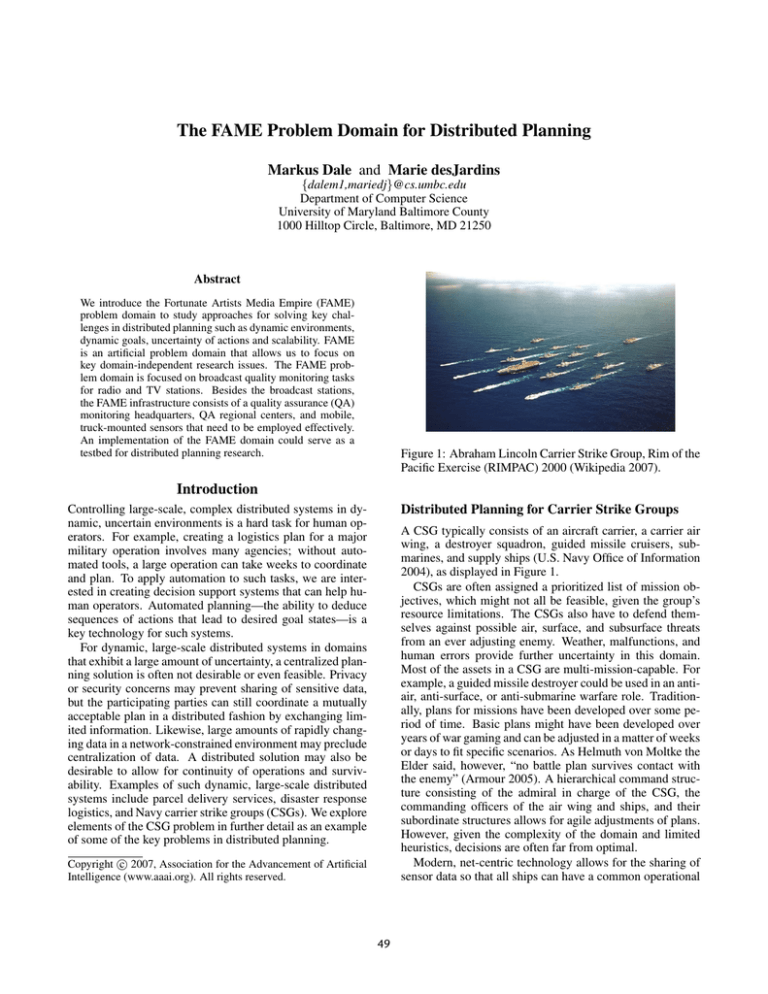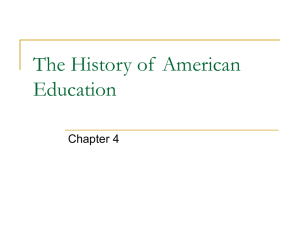
The FAME Problem Domain for Distributed Planning
Markus Dale and Marie desJardins
{dalem1,mariedj}@cs.umbc.edu
Department of Computer Science
University of Maryland Baltimore County
1000 Hilltop Circle, Baltimore, MD 21250
Abstract
We introduce the Fortunate Artists Media Empire (FAME)
problem domain to study approaches for solving key challenges in distributed planning such as dynamic environments,
dynamic goals, uncertainty of actions and scalability. FAME
is an artificial problem domain that allows us to focus on
key domain-independent research issues. The FAME problem domain is focused on broadcast quality monitoring tasks
for radio and TV stations. Besides the broadcast stations,
the FAME infrastructure consists of a quality assurance (QA)
monitoring headquarters, QA regional centers, and mobile,
truck-mounted sensors that need to be employed effectively.
An implementation of the FAME domain could serve as a
testbed for distributed planning research.
Figure 1: Abraham Lincoln Carrier Strike Group, Rim of the
Pacific Exercise (RIMPAC) 2000 (Wikipedia 2007).
Introduction
Distributed Planning for Carrier Strike Groups
Controlling large-scale, complex distributed systems in dynamic, uncertain environments is a hard task for human operators. For example, creating a logistics plan for a major
military operation involves many agencies; without automated tools, a large operation can take weeks to coordinate
and plan. To apply automation to such tasks, we are interested in creating decision support systems that can help human operators. Automated planning—the ability to deduce
sequences of actions that lead to desired goal states—is a
key technology for such systems.
For dynamic, large-scale distributed systems in domains
that exhibit a large amount of uncertainty, a centralized planning solution is often not desirable or even feasible. Privacy
or security concerns may prevent sharing of sensitive data,
but the participating parties can still coordinate a mutually
acceptable plan in a distributed fashion by exchanging limited information. Likewise, large amounts of rapidly changing data in a network-constrained environment may preclude
centralization of data. A distributed solution may also be
desirable to allow for continuity of operations and survivability. Examples of such dynamic, large-scale distributed
systems include parcel delivery services, disaster response
logistics, and Navy carrier strike groups (CSGs). We explore
elements of the CSG problem in further detail as an example
of some of the key problems in distributed planning.
A CSG typically consists of an aircraft carrier, a carrier air
wing, a destroyer squadron, guided missile cruisers, submarines, and supply ships (U.S. Navy Office of Information
2004), as displayed in Figure 1.
CSGs are often assigned a prioritized list of mission objectives, which might not all be feasible, given the group’s
resource limitations. The CSGs also have to defend themselves against possible air, surface, and subsurface threats
from an ever adjusting enemy. Weather, malfunctions, and
human errors provide further uncertainty in this domain.
Most of the assets in a CSG are multi-mission-capable. For
example, a guided missile destroyer could be used in an antiair, anti-surface, or anti-submarine warfare role. Traditionally, plans for missions have been developed over some period of time. Basic plans might have been developed over
years of war gaming and can be adjusted in a matter of weeks
or days to fit specific scenarios. As Helmuth von Moltke the
Elder said, however, “no battle plan survives contact with
the enemy” (Armour 2005). A hierarchical command structure consisting of the admiral in charge of the CSG, the
commanding officers of the air wing and ships, and their
subordinate structures allows for agile adjustments of plans.
However, given the complexity of the domain and limited
heuristics, decisions are often far from optimal.
Modern, net-centric technology allows for the sharing of
sensor data so that all ships can have a common operational
c 2007, Association for the Advancement of Artificial
Copyright Intelligence (www.aaai.org). All rights reserved.
49
The FAME Domain Description
picture. Rather than helping the top-level decision makers, however, this wealth of information can often be overwhelming without adequate decision support tools.
We define the fictional Fortunate Artists Media Empire
(FAME) quality assurance (QA) problem. FAME QA provides QA for thousands of radio and TV stations throughout
the lower 48 states of the United States of America. It monitors broadcasts for Big Brother Organization (BBO) violations such as the use of obscene language. It also monitors
advertising quotas. Its infrastructure forms a hierarchy that
consists of a quality assurance headquarters (QAHQ), 49
QA regional centers (QARCs), and mobile, truck-mounted
sensors used to monitor TV and radio broadcasts.
Key Problems and Challenges for Distributed
Planning
The CSG problem and other large-scale distributed systems
such as logistics and parcel delivery exhibit some overlapping problems and challenges:
1. Dynamic environment: The environment changes (e.g.,
weather and enemy actions).
Quality Assurance Headquarters (QAHQ)
2. Dynamic goals: Mission priorities and objectives change.
The Quality Assurance Headquarters (QAHQ) is located in
Austin, Texas. It is responsible for developing a schedule
of QA sampling and it receives sampling requests from advertisers or the BBO. Requests can also be generated as a
result of monitored violations of advertising quotas or BBO
regulations. There are two formats of sampling requests.
One request is for a specific radio or TV station, a specific
program, a specific timeslot and recurrence. This type of
sampling request allows for broadcast delays if previous programs run over schedule. The other request format is for a
specific station and time period. It monitors all programs
during that time period. QAHQ determines which Quality
Assurance Regional Centers (QARCs) can possibly cover
the requests and makes assignments accordingly. For a centralized planning approach, QAHQ determines unique assignments. However, radio or TV stations that are located
within sensor range of neighboring regions could be monitored from more than one region. In a distributed approach,
a request could therefore be assigned to multiple QARCs
and the QARCs would be responsible for deconflicting the
assignments. Alternatively, all of the requests could be assigned to the entire group of mobile sensors in a territory,
which would then need to coordinate in order to ensure the
best coverage. Actual BBO or advertising violations are
reported back to QAHQ via violation monitoring requests
(VMRs).
3. Uncertainty: Actions have uncertain outcomes, as in the
case of weapon systems malfunction, missed targets, or
targets that employ counter-measures to avoid detection.
4. Scalability: Many independent entities must be controlled
and coordinated. Ships and aircraft in the CSG are on the
order of tens of entities. Each one of those entities has
autonomous subsystems that may be interdependent with
numerous other subsystems.
In the next section, we describe the Fortunate Artists Media Empire (FAME) domain. FAME is an artificial domain
that allows us to focus and explore solutions to the core distributed planning issues while abstracting away some of the
real-world complexities such as naval doctrine and its representation for the CSG problem.
The Fortunate Artists Media Empire (FAME)
Problem Domain
FAME is a completely artificial distributed planning problem domain that incorporates the key problems and challenges described above: dynamic environments, dynamic
goals, uncertainty of actions, and scalability. We first describe FAME, and then discuss how these key challenges
are captured by this domain.
Quality Assurance Regional Center (QARC)
Each Quality Assurance Regional Center (QARC) has a
fixed geographical territory in which to employ its sensor
assets. The bounding boxes for each QARC are the same
size, but due to coastlines and borders some QARCs have a
smaller landmass to cover than others. For example, Area 1
covers the US land-portion of the geographical area bounded
by the latitude/longitude pairs 45N/130W and 50N/120W,
while Area 2 is bounded by 45N/120W and 50N/110W. The
bounding boxes of the 49 QARCs are shown in Figure 2.
The bounding boxes are aligned to 5-degree increments in
latitude and 10-degree increments in longitude. Each QARC
has a fixed assigned number of mobile sensors. QARCs can
also malfunction or have scheduled outages that would shut
down all mobile sensors in a given region. In such cases,
neighboring QARCs will attempt to cover high priority requests for neighboring radio or TV stations that could be
monitored from their territory. QARCs also process mon-
Figure 2: FAME map with a grid of 49 QA regional center
(QARC) territories (UT Austin 2007).
50
Experimental Parameters
itored broadcasts received from mobile sensors for correctness of advertising quotas and BBO violations. For observed
violations, QARCs generate high-priority VMRs, which are
sent back to the QAHQ. For BBO violations, these VMRs
are for a specific program for a specified length of recurrence, for example, a VMR to monitor every show of a specific disk jockey for one week. Advertising quota violations
result in VMRs of the offending station for a specific length
of time.
The FAME domain provides a large number of adjustable
parameters that can be used to map salient features from
actual domains. The following is a non-exhaustive list of
parameters that can be adjusted:
1. QAHQ Parameters: On the QAHQ level, we can change
the number of sampling requests and the fixed QA sampling schedule. We can also control the geographic distribution of the sampling requests and their priorities.
Mobile Sensors
2. QARC Parameters: For the regional level, we can adjust
the number and the geography of the regions. We can
model the frequency and distribution of QARC outages.
The number of sensors could be the same for every region
or proportional to the number of broadcast stations.
Each QARC has a fixed number of assigned mobile, truckmounted sensors. The mobile sensors must stay in the territory of their assigned QARC. Each sensor has a range that
determines how close it must be to a radio or TV station in
order to monitor its broadcast. Mobile sensors might be assigned to monitor stations in neighboring territories that are
within their monitoring range. They have a maximum speed
to transition to a new monitoring location but cannot monitor
any broadcasts while moving.
3. Mobile Sensor Parameters: Mobile sensors could have
different monitoring capabilities. They could monitor either both, radio and TV broadcasts, or just one of those
media. Sensors can also have different monitoring ranges.
Other sensor parameters include probabilistic maximum
speeds and probability of malfunction.
Quality Assurance Methodology
4. Communication Environment Parameters: We can model
different probabilities of delayed or dropped traffic.
There are scheduled QA samples and dynamic sampling requests of different priorities that must be covered by assigning collection sensor assets. If feasible, collection assets
must monitor all VMRs. They should also attempt to monitor the highest-priority requests. The number of collection
requests by far exceeds actual collection capabilities.
5. Broadcast Environment Parameters: We can adjust the
number and geographic distribution of TV and radio stations. We can further model probabilistic broadcast distances and adherence to published broadcast schedules.
Communication and Broadcast Environment
Mapping FAME Problems to Key Challenges
QAHQ and the QARCs are connected via a high-speed
wide-area network. All mobile sensors are uniquely named
and can communicate directly with any QARC or other
mobile sensor within their own region and neighboring regions. However, the communication infrastructure is primarily used for collection traffic that transports monitored
broadcasts to the appropriate QARCs for QA processing and
archival. Therefore, additional communication needed for
command and control (C2) must be kept to a minimum. Due
to the real-time nature of collection traffic, C2 traffic may be
delayed or even dropped.
Our broadcast environment consists of radio and TV stations at known locations and published broadcast schedules.
Each broadcast station has a probabilistic maximum broadcast range.
1. Dynamic environment: Quality Assurance Regional Center (QARC) outages, mobile sensor outages, and differing
maximum speeds contribute to a highly dynamic environment.
2. Dynamic goals: With new monitoring requests of differing priorities, goals are constantly in flux. Monitored violations result in new high-priority requests.
3. Uncertainty: Mobile sensors have changing maximum
speeds. Outages of mobile sensors and QARCs require
replanning to cover highest-priority requests.
4. Scalability: The FAME domain allows us to experiment
with large numbers of QARCs, and large numbers of mobile sensors per QARC. Different multiagent organizational paradigms like coalitions and hierarchies might allow us to implement more scalable solutions.
Quality Metrics
Summary and Future Work
For this problem we propose two different quality metrics
that determine the “goodness” of a solution:
We introduced the Fortunate Artists Media Empire (FAME)
artificial problem domain, which allows us to examine distributed planning approaches in an abstract, dynamic environment that includes challenges such as dynamic goals, uncertainty, and scalability issues. In the FAME domain problem, we aim to allocate mobile, truck-mounted sensors to
monitor broadcast stations according to prioritized monitoring requests. This domain provides a large number of experimentation parameters that can be mapped to salient features of actual domains. These features can then be explored
1. Priority Weighting Metric (PWM): This metric provides
different weights for each level of priority. Higherpriority requests have a much higher weight than lowerpriority requests, but there are no penalties for sensor
movement and the resulting losses of coverage.
2. PWM with Movement Penalty (PMP): This metric also
uses priority weighting, but penalties are assigned for sensor movement and the resulting losses of coverage.
51
Lesser, V.; Decker, K.; Wagner, T.; Carver, N.; Garvey, A.;
Horling, B.; Neiman, D.; Podorozhny, R.; Prasad, N. M.;
Raja, A.; Vincent, R.; Xuan, P.; and Zhang, X. Q. 2004.
Evolution of the GPGP/TÆMS domain-independent coordination framework. Autonomous Agents and Multi-Agent
Systems 9(1):87–143.
Modi, P. J.; Shen, W.-M.; Tambe, M.; and Yokoo, M.
2003. An asynchronous complete method for distributed
constraint optimization. In Proceedings of the second international joint conference on Autonomous agents and multiagent systems (AAMAS ’03), 161–168. New York, NY,
USA: ACM Press.
U.S.
Federal
Communications
Commission
(FCC).
2006.
Broadcast station totals.
http://www.fcc.gov/mb/audio/totals/bt061231.html.
[Online; accessed on Sept. 11, 2007].
U.S. Navy Office of Information. 2004. The Carrier Strike
Group. http://www.chinfo.navy.mil/. [Online; accessed 07
May 2007].
UT Austin.
2007.
Based on map provided
courtesy of the University of Texas Libraries.
http://www.lib.utexas.edu/maps/united states/usa blank.jpg.
[Online; accessed on 23 April, 2007].
Wikipedia.
2007.
Carrier Strike Group
—
Wikipedia,
The
Free
Encyclopedia.
http://en.wikipedia.org/wiki/Carrier battle group. [Online;
accessed 23 April 2007].
Zeigler, B. P.; Kim, T. G.; and Praehofer, H. 2000. Theory
of Modeling and Simulation. Orlando, FL, USA: Academic
Press, Inc.
against different distributed planning approaches. The domain task model—the monitoring requests—is a very flat
task model consisting of only two subtasks, namely the potential movement of a mobile sensor followed by the actual
monitoring subtask.
Our next step will be to model a realistic distribution of
licensed broadcasting stations in the United States based on
U.S. Federal Communications Commission data (U.S. Federal Communications Commission (FCC) 2006). Rather
than implementing an ad-hoc model and simulation from
scratch, we will use the JAMES II modeling and simulation
framework (Himmelspach & Uhrmacher 2007), which supports modeling formalisms based on DEVS (Discrete EVent
System specification) (Zeigler, Kim, & Praehofer 2000).
With sets of generated broadcast schedules and monitoring requests, we will then explore elements of distributed
planning approaches such as the Distributed System for Interactive Planning and Execution (DSIPE) (desJardins &
Wolverton 1999) and Generalized Partial Global Planning
(GPGP) (Lesser et al. 2004), as well as distributed constraint
optimization approaches such as Adopt (Modi et al. 2003)
within that testbed. We also plan to explore multiagent organizational paradigms such as the use of dynamic coalitions
(Horling & Lesser 2005), to increase scalability and survivability in pursuit of a hybrid distributed planning approach
for the FAME domain.
For a class of distributed planning algorithms, the FAME
domain could be used as a standardized environment and
testbed that would allow the direct comparison of algorithms similar to RoboCup (Kitano et al. 1997) or the ACTIVE testbed designed for the DARPA Coordinators program (Emami et al. 2006).
References
Armour, P. G. 2005. To plan, two plans. Communications
of the ACM 48(9):15–19.
desJardins, M., and Wolverton, M. 1999. Coordinating a
distributed planning system. AI Magazine 20(4):45–53.
Emami, G.; Cheng, J.; Cornwell, D.; Feldhousen, M.;
Long, C.; Malhotra, V.; Starnes, I.; Kerschberg, L.; Brodsky, A.; and Zhang, X. 2006. ACTIVE: Agile coordinator testbed integrated virtual environment. In Proceedings
of the Fifth International Joint Conference on Autonomous
Agents and Multiagent Systems (AAMAS ’06), 1580–1587.
New York, NY, USA: ACM Press.
Himmelspach, J., and Uhrmacher, A. 2007. Plug’n simulate. In 40th Annual Simulation Symposium (ANSS ’07),
137–143. Los Alamitos, CA, USA: IEEE Computer Society.
Horling, B., and Lesser, V. 2005. A Survey of Multi-Agent
Organizational Paradigms. The Knowledge Engineering
Review 19(4):281–316.
Kitano, H.; Asada, M.; Kuniyoshi, Y.; Noda, I.; and Osawa,
E. 1997. RoboCup: The robot world cup initiative. In
Johnson, W. L., and Hayes-Roth, B., eds., Proceedings of
the First International Conference on Autonomous Agents
(Agents’97), 340–347. New York: ACM Press.
52





